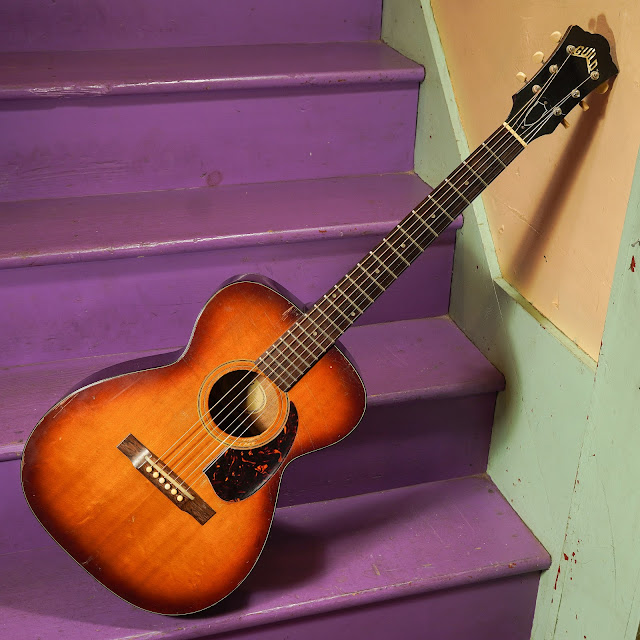1964 Guild F-20 0-Size Guitar
If looks could kill, right? This '64 Guild F-20 was built in Hoboken, NJ and has the usual sound for the time for this model -- full despite its size, woody, punchy, and quite loud. This one has its share of minor wear and tear throughout but is in pretty good shape regardless. It's also all-original except for the new saddle.
I suggest this model for those looking for an alternative to a Martin 0-18 or 00-18 but who want a more Gibson-like feel and note separation and a little more bite in the upper mids. The necks on these are quick and easy and while they sound a lot like a good 0-18, they do have a woodiness to them that's a bit reminiscent of Gibson LG-2 models in their own way.
Post-repairs it's playing spot-on and is ready to go.
The work was at first straightforward but I did have to fuss with the neck joint a bunch to set the angle just right. The dovetail on this one was practically a tenon joint -- the edges did not want to hold in place and when clamped to glue it wanted to scoot back into an overset angle. I made the decision to double-bolt the joint as well as glue it, and so you'll find a couple of hidden bolts at the neckblock on the inside. I have to do this now and then on Guild dovetails when they've been cut poorly and/or have various amounts of damage.
Repairs included: a neck reset, fret level/dress, bridge reglue, saddle slot expansion, new bone saddle, setup and adjustments.
Top wood: solid spruce
Back & sides wood: solid mahogany
Bracing type: x
Bridge: rosewood
Fretboard: rosewood
Neck wood: mahogany
Action height at 12th fret: 3/32” bass 1/16” treble (fast, spot-on)
String gauges: 54w-12 lights
Neck shape: medium C
Board radius: 9 1/2"
Truss rod: adjustable
Neck relief: straight
Fret style: medium
Scale length: 24 3/4"
Nut width: 1 5/8"
Body width: 13 3/4"
Body depth: 4"
Weight: 3 lbs 3 oz
Condition notes: it's all-original save the bone saddle and crack-free save a small hairline 3" one, tight, at the waist on the rear. Kerfing covers the whole hairline so it's a non-issue. I had to use an extra-wide saddle to get the intonation dialed-in. The original bridge/saddle was misplaced by about 1/32" or so at the factory and extra leeway towards the rear of the bridge was needed. So: wider saddle. Otherwise, wear and tear on this guitar is what I'd call "medium" -- there's weather-checking in the finish and plenty of pickwear on the upper bout and near the soundhole. There's light scratching throughout the rest of the body. The hardware has, of course, aged -- and a few mounting screws are replacements.
It comes with: a presumably-original chip case.





















Comments